Hidden Gem in Spain: Medieval Espluga de Francoli and its Architecture
One of the hidden gems in Spain, is the small and picturesque medieval town of Espluga de Francoli.
Although it is off the beaten path, this town with medieval architecture is worth a visit for authentic antient atmosphere of its streets and for nearby monastery and other attractions.
I found out about Espluga de Francoli by randomly “walking” on Google maps around Tarragona, Catalonia region of Spain. This is how I decide on my future travel destinations, check out my post about this.
When I saw oval odd shaped, clearly medieval streets layout, I knew I had to visit this town!
In this post I explain why lesser known l’Espluga de Francoli is worth visiting, especially if you are into medieval towns. I share the practical information from my trip. I explain how to get to the town, where to stay, where to eat, and its attractions: museums, churches, castle, and wineries.
What is Espluga de Francoli
Espluga de Francoli (L’Espluga de Francolí or Espluga de Franco) is a picturesque medieval town in Catalonia, Spain. Its establishment dates back to ancient times, with evidence of human presence in the area since the Paleolithic era.
However, the town gained importance during the Middle Ages because of its nearby Monastery of Poblet. The monastery, founded in 1150, played a crucial role in shaping Espluga’s development.
Espluga de Francoli is closely associated with the Berguera family, a Catalan noble family who owned the land until the 20th century.
Over the centuries, the town evolved, but it managed to preserve its old charm and ancient looking winding streets and historical houses.
It is believed that the town got its name from the Latin word ‘espluga’, meaning ‘cave’ or ‘pit’, which refers to the numerous caves and cavities in the area. The better-known Font Major cave was discovered here in 1853 (see Espluga Caves section)
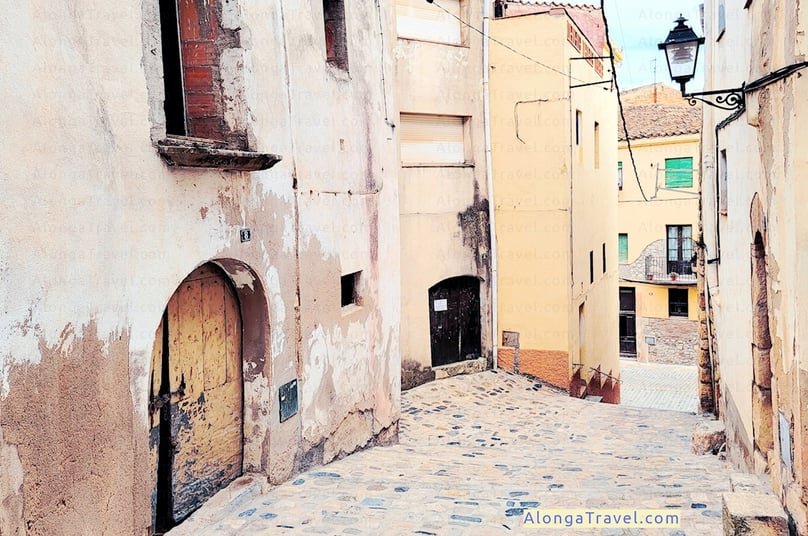
Walking through the streets, you will feel as though you have been transported back in time.
Over the centuries, the town evolved, but it managed to preserve its old charm and ancient looking winding streets and historical houses.
It is believed that the town got its name from the Latin word ‘espluga’, meaning ‘cave’ or ‘pit’, which refers to the numerous caves and cavities in the area. The better-known Font Major cave was discovered here in 1853.
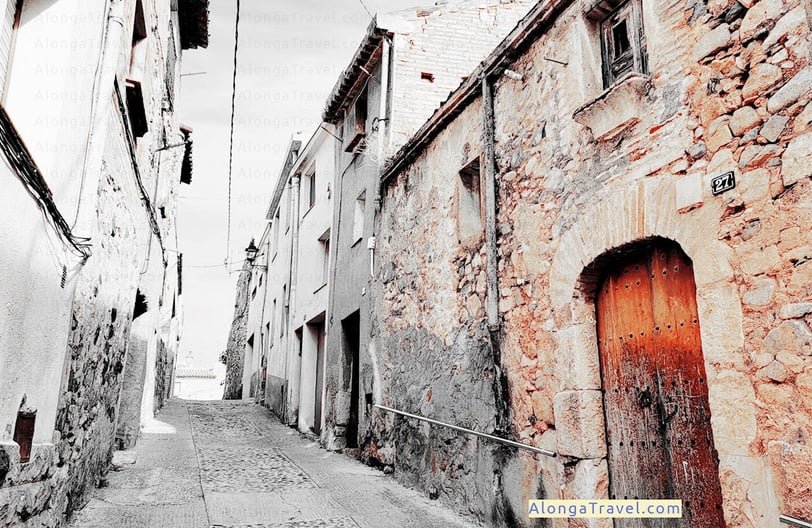
Espluga is situated on a hilltop in the midst of vineyards and is surrounded by mountains. Nearby is a Castillo de L’Espluga de Francoli.
As I’ve mentioned, I found this town while exploring Catalonia on the map. I also found another similar town in the area, and I decided to combine 2 of them for my day trip visit.
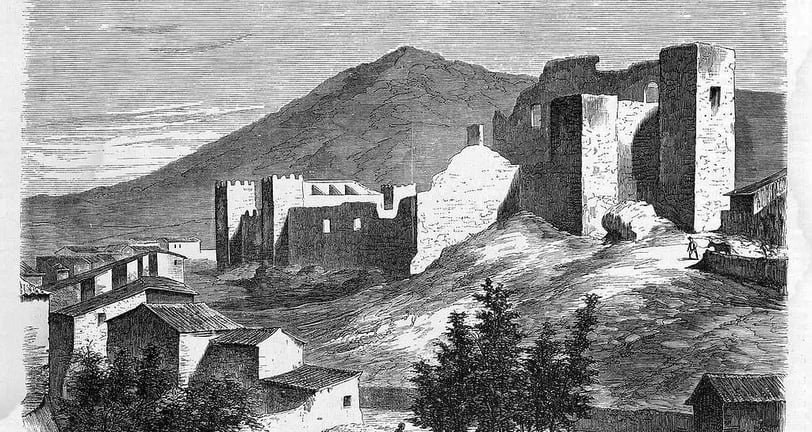
Arriving in Espluga de Francoli
I left from Arch de Triumph metro station in Barcelona, Spain where I was staying at the time. I used one of my tickets from the 10-tickets bundle to get to BARCELONA SAINTS towards LLEIDA. I bought a one-way ticket to L’Espluga from an automated ticket machine for €10.
In retrospect, it was better to buy a round-trip ticket for €18, not only because it saves money, but because it helps you avoid hustle and “shock” when you find out there is no a place to buy the ticket back to Barcelona in Espluga!:)
More about this in how to get to l’Espluga section of this post.
From the moment I arrived and saw a wall of colorful houses nested on a rock wall, I knew I made a great decision to visit! The rest of my visit only confirmed this. So, yes, Espluga de Francoli is absolutely worth your visit!

L’Espluga de Francoli is a great destination for a solo trip, if you’re adventurous
While you will probably think that visiting Lespluga as a couple is very romantic, I believe it’s more interesting to visit it alone. Why is that?
Firstly, it’s located off the beaten path, and getting there is a 2-hour adventure in itself. And being alone, you experience it more fully.
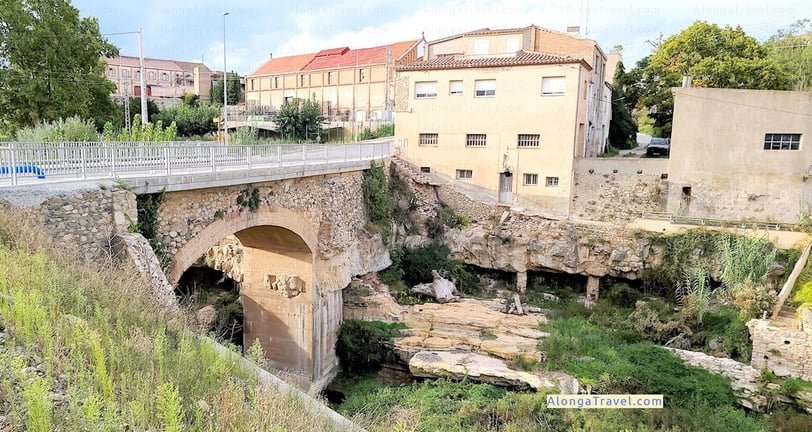
Across the river from L’Espluga de Francoli by the train station
And when you get there and see this amazing authentic town, with its older architecture in many parts not touched by tourism yet. When you walk on the winding alleys seeing no one, you feel you just got transported back in time!
You walk completely convinced you’re sometime in the 15th century, until about 15 minutes later you see someone, and that person will be wearing modern clothes and then you start suspecting that maybe you’re in the 21st century after all. But not before seeing a person! 🙂

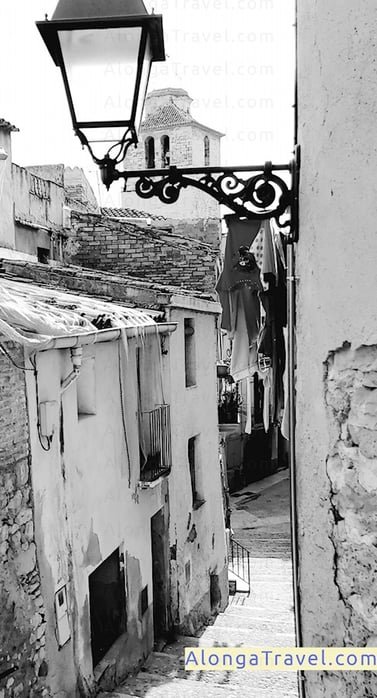
So, why do I think it’s better to come visit alone, besides my firm belief that you connect deeper with the surroundings when you travel alone?
I am pretty sure that you get a more intense feeling because you’re out there alone, slightly vulnerable and away from other tourists, all set to experience all the feelings that overwhelm you to the fullest!
I’m sure visiting with someone could be nice as well, but do you understand what I meant?
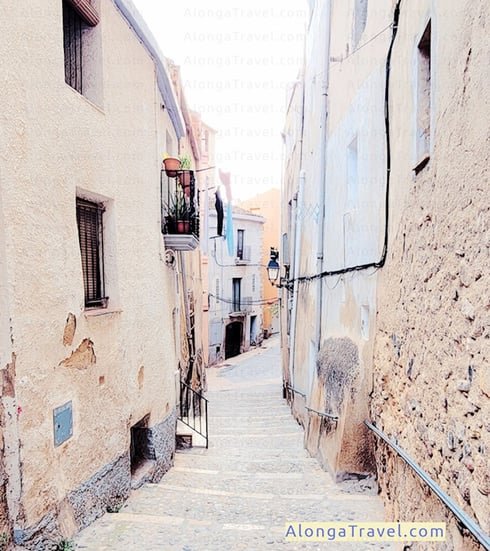
This dreamy medieval alley was mine and mine alone! This is how I wanted it to be on this street!:)
I didn’t want to talk to anyone to spoil this magic.
And then, after you enjoy the feeling of the old times, you go to the center of the town to enjoy the cozy perks of Civilization, like several small shops and cafes, restaurants, and museums; it’s such a great combination!
Now, this part of the visit is done better with a partner! 🙂 I guess there are pluses and minuses to everything!

The main square with the views of New Church of Sant Miquel
Afterward, if you still have time and energy left, there are many wonderful hikes and great bike routes around Espluga!

One of the medieval houses in Espluga I couldn’t stop taking pictures of. It’s just such a cool house and so wonderfully odd-shaped!
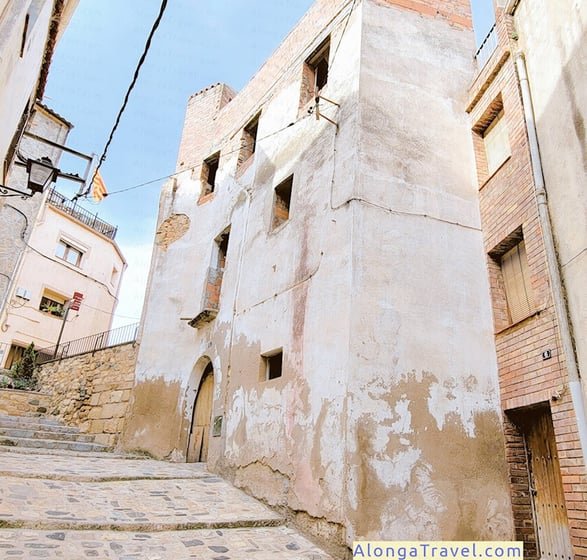
Architecture of Espluga de Francoli
Espluga de Francoli is a gem for lovers of older architecture! The winding medieval streets and beautiful old buildings are a unique sight to see, oozing authenticity.
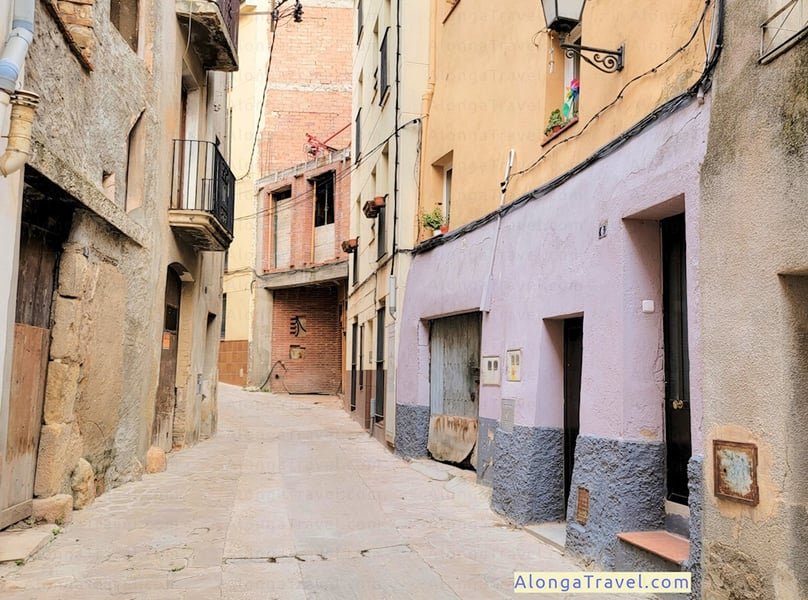
By the way, if you enjoy old architecture, check out my post about different types of interesting old buildings in Europe.
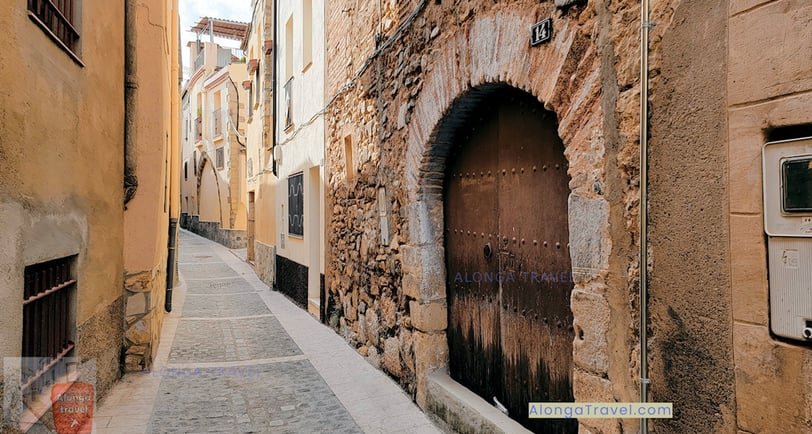
You will see examples of Romanesque architecture in The Church of Sant Miquel, with more information about this church later on in the post.
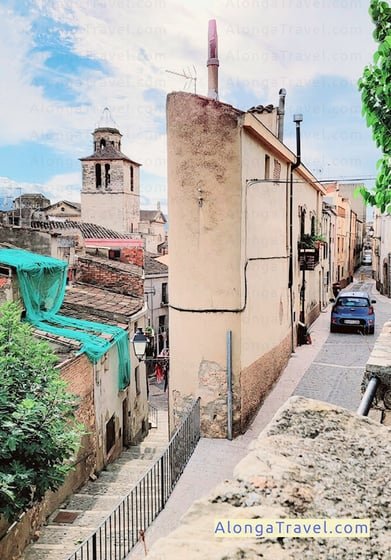
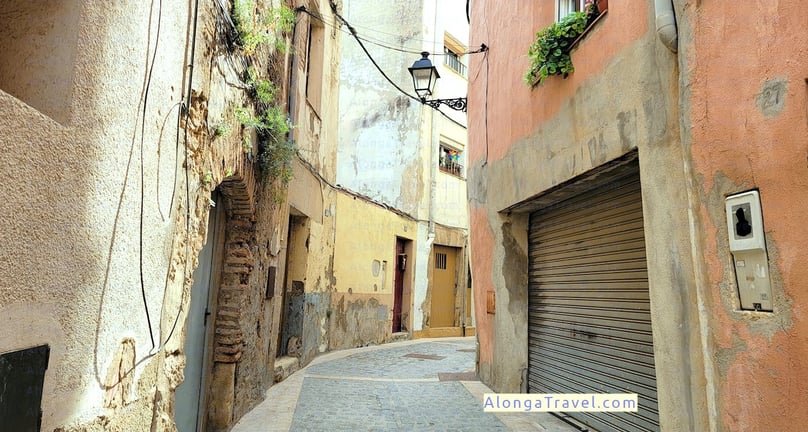
Rounded medieval street in Espluga de Francoli
Defensive walls
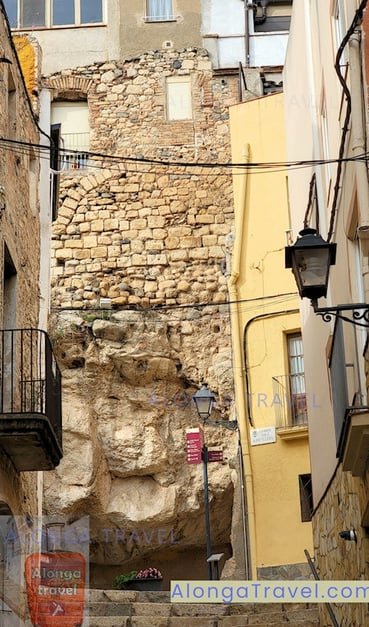
One of the most notable features of Espluga de Francoli is its defensive walls. These walls were built in the 13th century on already existing cliff walls to protect the town from invaders.
Today, the walls are still in excellent condition and provide a beautiful backdrop for historical houses.
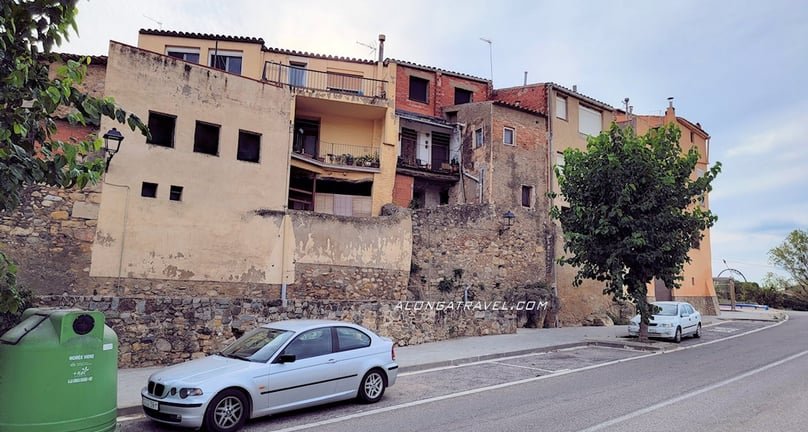
cliff houses
Besides the remains of the city walls in Espluga de Francoli, you will also see some very unique architecture of the medieval houses built on the town’s natural cliff walls, like the houses in this picture (above and below)!
Look at the bus stop in a cave under the cliff with a bench. What an unusual bus stop location! I was a bit unsettled when I went there, but luckily, no houses fell on me. 🙂
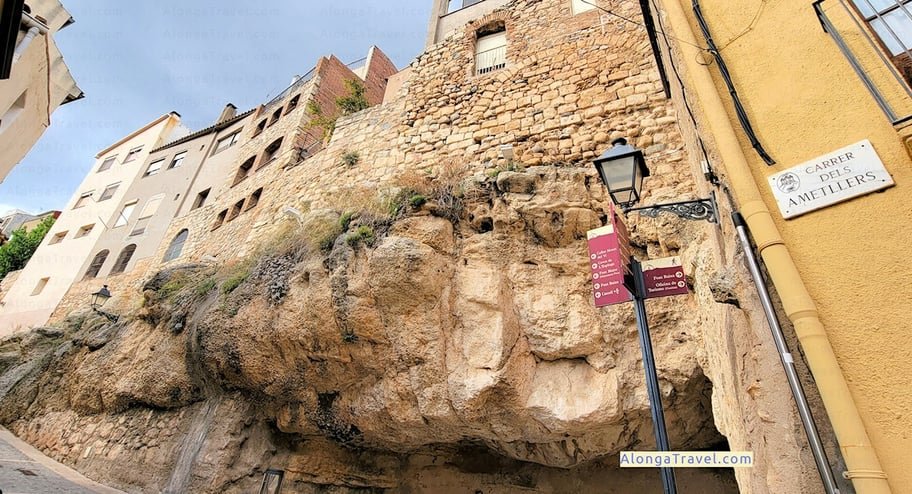
And what magnificent houses they were!
BTW, if you’re wondering how much the houses are priced nowadays – the old ones, that weren’t remodeled are around 40,000 euros. The ones that were remodeled into beautiful modern town houses are around 150,000 euros.
I was curious, so I checked.
Well-preserved remains of the city wall in Espluga with houses built on it and a bus stop in an open cave.
Where is Espluga located
L’Espluga de Francoli, a commune in the Province of Tarragona , Catalonia , Spain , is located halfway between Tarragona and Lleida. You could easily miss this town if you didn’t know where to look. So, you need to check the map to find it.
The important Cistercian Route in Europe
Espluga de Francoli is located in the middle of the Cistercian Route.
The Cistercian Route in Spain is a network of monasteries, churches, and abbeys that were founded by the Cistercian order of monks.
The route stretches from the north of Spain to the south, and includes some of the most beautiful and well-preserved medieval architecture in Europe. It includes the monasteries of Poblet, Santes Creus, Vallbona de les Monges.
Cistercian monastery of Poblet, one of the largest in Spain, was declared a World Heritage by UNESCO in 1991. It is only 4 km away from l’Espluga.
The Cistercian Route is a great way to experience the Spanish countryside and learn about the history of the Cistercian order.
Modern l’Espluga de Francoli
The town’s population is just over 3,000 people. I haven’t seen many people on the streets other than on the main square as my visit was during the off-season. This definitely added to the surreal feeling of being transported back to medieval times.
The town gets more crowded in summer when the tourist season picks up because while Espluga is relatively unknown to outsiders, it’s very popular in the Tarragona region and even in the wider Catalonia area. And it’s for a reason!
The locals you will see will most likely greet you in Catalan – “Bon dia”.
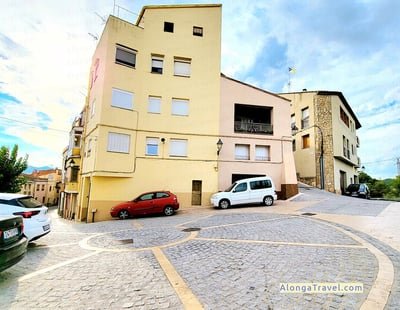
An interesting fact. You might already know some Catalan, if you’ve been to Portugal, as the languages have some similarities. In fact, Portuguese and Catalan have more similarities between them than with Spanish language!
BTW, I have many posts about Portugal on Alonga Travel.
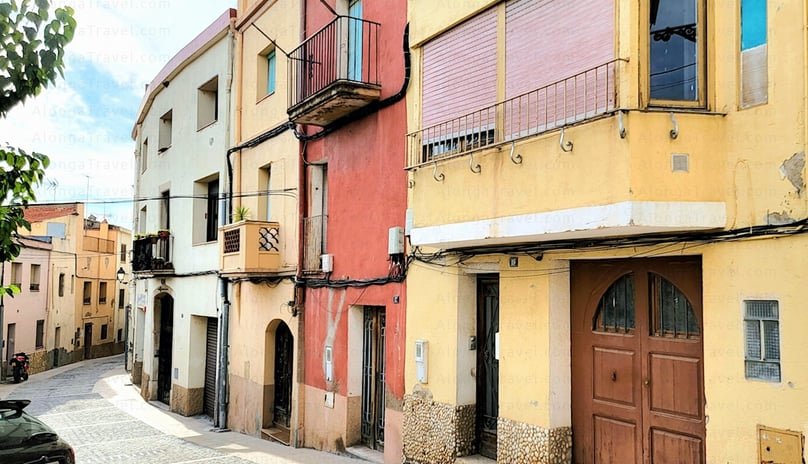
Cats of Espluga
But don’t worry—even if you won’t see many two-legged inhabitants while walking the alleys, you will see plenty of friendly four-legged ones in L’Espluga! And they might even generously let you pet them!
A smart-looking orange cat wanted to be my friend in Lespluga, Catalonia, Spain.
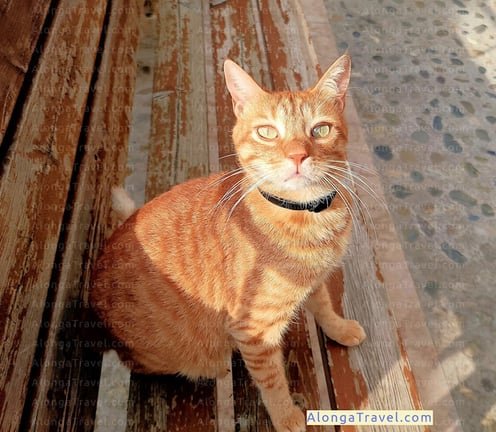
Cats are pretty relaxed out there – the food is good, and the views from their day-beds are amazing! 🙂
If you like cats, you should visit Kotor, Montenegro, there are so many of them, and they’re a part of attraction.
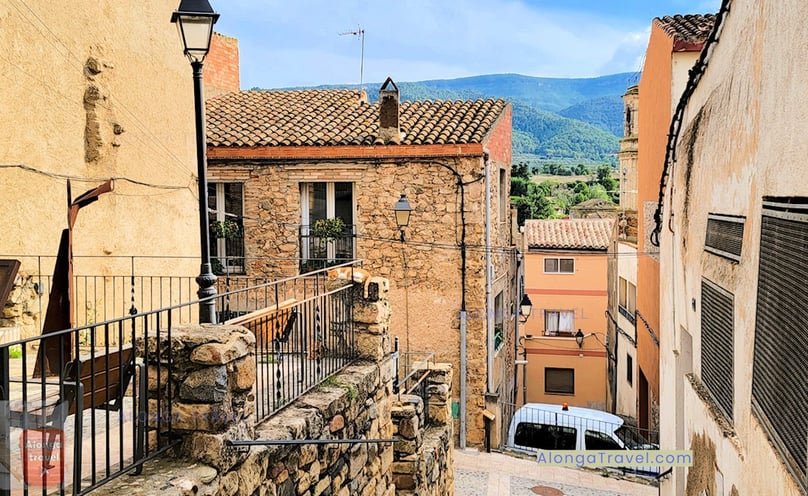
Look at the middle of this pic below. Do you see this cat’s day-bed? Wouldn’t you like to nap there overlooking such a wonderful view of the mountains yourself? 🙂 Such lucky cats!
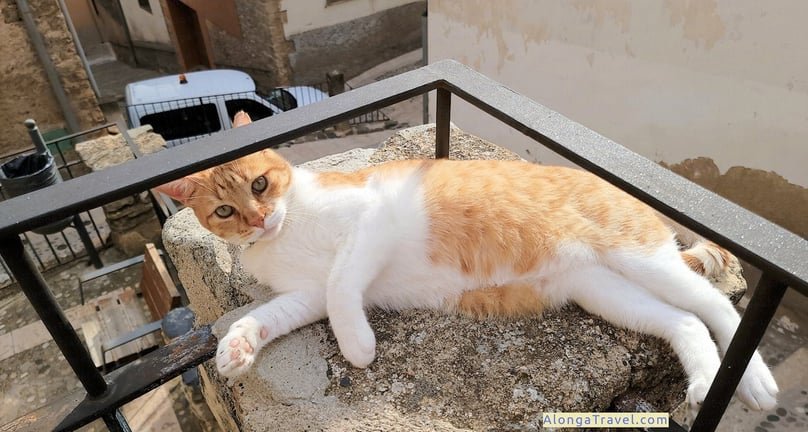
This kitty was also very friendly and wanted to play. He was a bit upset in the beginning that I interrupted his sleep on its royal bed, though.
What to do in Espluga de Francoli
From its medieval allies, an interesting castle and monastery, to its churches, there’s plenty to explore in Espluga.
And if you’re a fan of wine, you’ll be pleased to know that the town is home to some of the best wineries in the region.
Below is the map of tourist attractions in l’Espluga de Francoli.
Tourist map (mapa turistic)
Here is a map from the local tourist board of all top attractions listed, along with all restaurants.
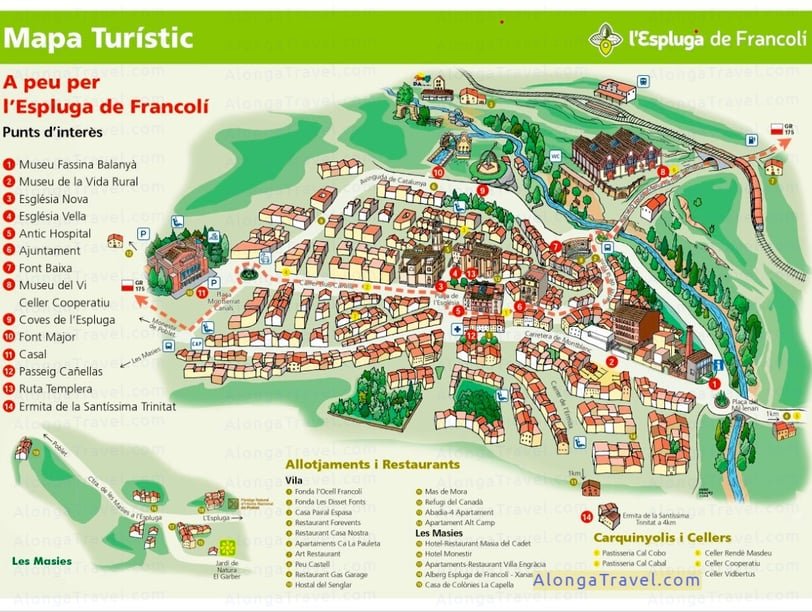
Below are top attractions in Espluga de Francoli.

The Church of Sant Miquel (Esglesia vella)
The church of Sant Miquel, or Old Church, is the centerpiece of Espluga, along with the New Church of Saint Miquel (left side on the pic above). The church was built in the 13th century, and is a classic example of Romanesque architecture.
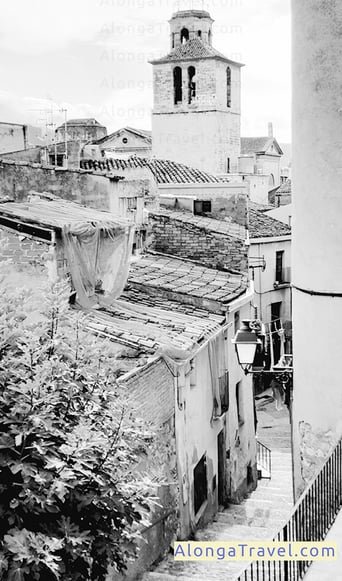
The exterior of the church is simple, but the interior is very ornate, with beautiful frescoes and stained-glass windows.
Església Nova de Sant Miquel
The church was burned down in 1873 and then rebuilt on the same place, using the same original 13th century stones.
The church is open to the public, and there is also a small museum attached to it.
It is located on the main square, so you won’t miss it.
An old historic alley leading to the back of New Church of Saint Miquel
Archeological museum Coves de l’Espluga
Coves de l’Espluga de Francolí – Una porta al passat prehistòric del nostre territori (covesdelespluga.info) (choose English)
Espluga de Francolí is home to the first Palaeolithic sanctuary in Catalonia, with over 300 engravings dating back around 37,000 years. Discovered on October 30, 2019 by Josep Maria Vergès of the Catalan Institute of Human Paleoecology and Social Evolution (IPHES), the sanctuary features figurative representations of animals and abstract symbols.
This site is considered one of the most significant collections of its kind in the Mediterranean Paleolithic region.
Unfortunately, the gallery cannot be visited as they are located on soft sandy silt layers in a small area with difficult access. But you can see pictures of them.
Address: Catalunya Avenue, 43440, La Espluga de Francoli (Tarragona)
The cultural Route
There is Cultural Route that includes the Rural Life Museum, the Wine Museum, the Font Major Cave and the Fassina Museum.
The Museum of Rural Life
There is an Ethnographic Museum in Espluga, called of the Museum of Rural Life, which is definitely a hidden gem and well worth visiting! It’s a wonderful display of local history and culture, the journey through Catalan rural agricultural life from 1900 to 2000.
You will have a chance to stand in the old rural kitchen, to see all the pots and utensil, used in that kitchen, and see mannequins wearing the order period clothes.
You will see old furniture and horse-drawn carriages, plus many odd and cool things!
Each exhibit has English write ups on each piece throughout the museum. And after you’re done, you can eat a snack on a terrasse you can get from an adjusted food booth.
This museum is owned by the Carulla Foundation. It was created in 1988 by architect Lluis Carulla i Canals in the Carulla family’s manor house. He donated collections of utensils and tools. In 2008, architect Daniel Freixes expanded and modernized the museum.
Address : Ctra. de Montblanc, 35, 43440 L’Espluga de Francolí, Tarragona, Spain

The back door to Museu de la Vida Rural. The museum from the front looks modern, but I liked the back alley with a view to a cool old tall chimney more. This chimney is from Fassina Balanyà, an old distillery of spirits.
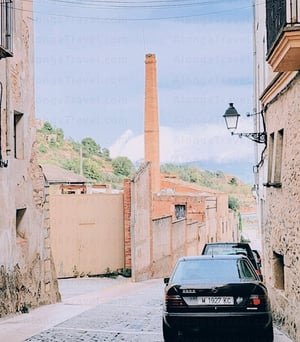
Fassina Balanyà
Fassina Balanyà is an old distillery of spirits from the 1830s. You can see the old and restored machinery here, and learn the production process for obtaining spirits and other derivatives from the grape
WINE MUSEUM OF L’ESPLUGA DE FRANCOLI
Starting from mid-19th century, cultivation of vines became an important factor in the development of the region of Espluga in Tarragona. If you like architecture and wine, you will be delighted to visit this Wine Museum.
The Bodega Cooperativa is a modernist wine cellar designed by Lluís Domènech i Montaner and later completed by his son Pere. The buildings is known for its large windows, skylights, mosaics, and sculptures.
The cooperative was established in 1904 by local wine growers and is still operated by its members.
They produce award-winning wines and offer tours and tastings. It is a must-see for architecture and wine enthusiasts
You can learn about wine-making history and techniques, view museum displays, and use audiovisuals on the 3rd floor.
And once you’ve learned all the theory of wine-making and wine-tasting, you can practice your knowledge at the local restaurants! 🙂
Attractions outside of L’Espluga de Francoli
THE CASTLE DE MILMANDA – FAMILIA TORRES
The town also has a castle, which was built in the 11th century, and was originally used as a fortified monastery. Over the years, it has been used as a residence for the Counts of Barcelona, a military base, and even a prison.

The Castle Milmanda is located outside of the town, and I’m not sure you can go inside at the moment, but you better check the current situation! The grounds of the castle are nice and this makes for a beautiful hike to there.
Sadly, I didn’t get the chance to visit the castle, even though I really wanted to. I’ve chosen to stop in Montblanc (another wonderful mediaeval town) on the way to L’Espluga, and I had to restrict my visit to the train hours, and I run out off time. I’ll be back!
Poblet Vimbodí Natural Park
Poblet Vimbodí Natural Park and the Prades mountains, where you can find great hiking and biking trails, is only 2 km away from the town.
Montblanc and Vimbodí i Poblet towns
Nearby towns are Montblanc and Vimbodí i Poblet and both are really worth visiting! You would be able to combine 2 towns total on your 1-day itinerary from Barcelona and using the public transit, but not all 3. Most people would choose Montblanc as an addition to visiting l’Espluga de Francoli on the same day, coming from Barcelona.
Perhaps, save Vimbodí i Poblet for another trip? To make your more familiar with the area, check the map section.
Where to eat in L’Espluga de francoli
Art Restaurant
– Seasonal contemporary Catalan cuisine
– Located in a renovated old rural farmhouse
– Address: Camí Clos, s/n, 43440 L’Espluga de Francolí, Tarragona
GAS GARAGE RESTAURANT
– Signature handmade pizzas made with high-quality ingredients
– Also offers burgers, pastas, and other dishes
– Address: Av. Catalunya, 16, 43440 L’Espluga de Francolí, Tarragona
The Ocell Francolí Rural Family Hotel and restaurant.
– Traditional Catalan cuisine with new trends and high-quality products from the Tarragona region
– Popular dishes include snails, wild boar stew, pig’s trotters, trout with walnuts, grilled meat, and seasonal calçotada.
– Address: 43440 L’Espluga de Francolí, Tarragona, Spain
Where to stay in L’Espluga de francoli
Here are a few lodging options:
There are some (though not many) individual options for an overnight stay in L’Espluga, and there is also a huge resort at the outskirts of the town, MAS DE MORA. Or you could go to Espluga for a day- trip from Barcelona (2 hour’s trip). Staying overnight is preferable, as you will have time to explore nearby monasteries as well!
- The Ocell Francolí Rural Family Hotel and restaurant.
- Espasa Manor House (Masovera)
- A rural stay: Mas de More
Hostal de Senglar for a budget stay.
Pictures of old doors in Espluga
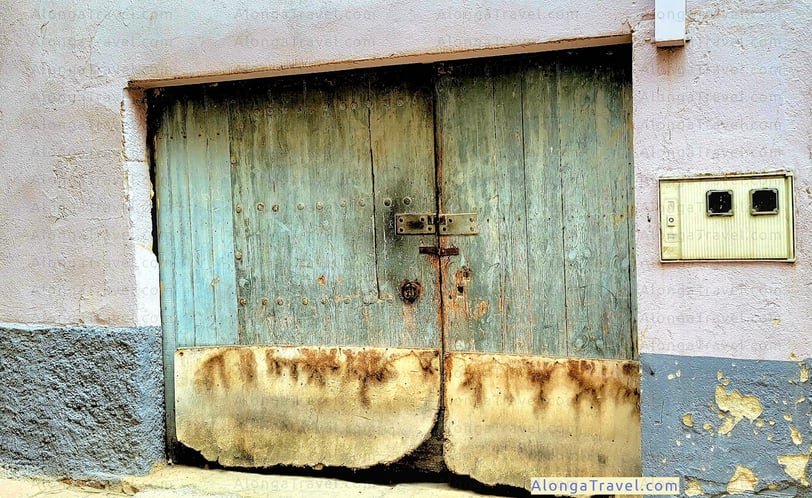
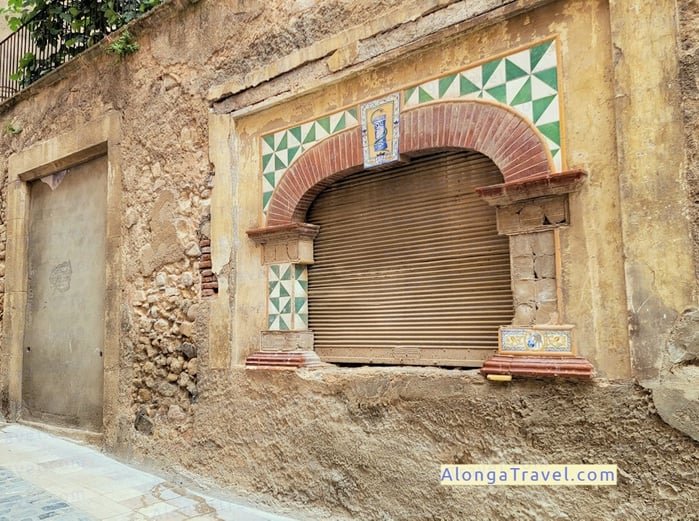
How to get to L’Espluga de Francoli
Transportation options:
– Drive: Approximately 1.5 hours, gasoline cost around $20-35 one way
– Public transportation: bus or train. Train fare is 10 euros one way, 18 euros for a return ticket
PUBLIC TRANSPORTATION TO ESPLUGA
You can get to L’Espluga De Francolí by Bus or Train
Getting to L’Espluga de Francoli by train
There is Renfe Cercanías train from BARCELONA SAINTS towards LLEIDA and the price will be around $11 one way, or a round-trip ticket (my recommendation!) for $20.
You would need to buy a separate ticket to get to Barcelona Saints first.
Use these train lines:
- Train R13
- Train R14
You can’t buy a Renfe Cercanías train ticket online. You can only buy it at the train station on the day of travel, but you can check the schedule on this website https://www.renfe.com/es/en
Important! Don’t get alarmed at the train station when you won’t find a ticket machine, or anyone to sell you a ticket, and you didn’t buy a round ticket!
In general, it’s more expensive to pay for the ticket, once you already on Renfe Cercanías train (a train that travels in the nearest to some big city area. Cerca in Spanish means – close by). But, in case when a town is so small that it doesn’t have its own ticket machine, the train conductor will sell you one for the regular price.
Getting to Espluga de Franco by bus
Use lines L1520 and L1664.
Bus stations close to L’Espluga De Francolí in L’Espluga De Francolí| Espluga De Franco
The nearest bus stops to L’Espluga:
- Av. Catalunya – Ctra. T-700, L’Espluga De Francolí
- Pl. Del Centenari
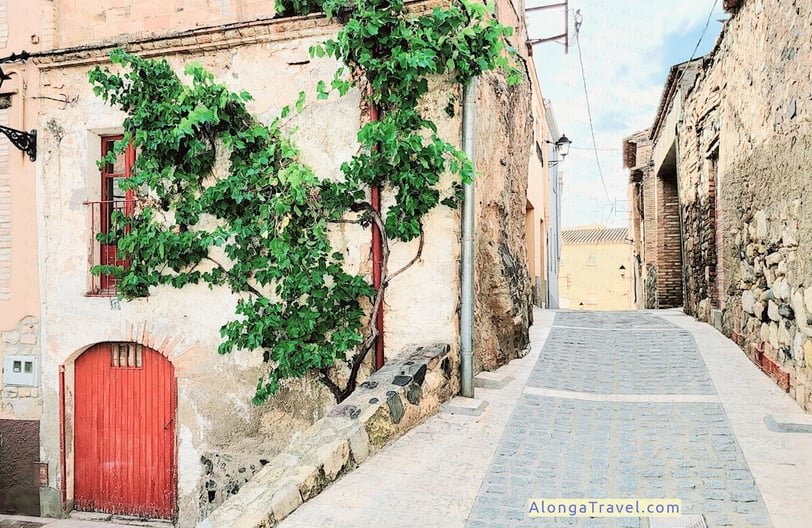
So, whether you’re looking to explore Catalonia’s medieval architecture, its history, hike around the town or sample the town’s delicious food and wine, L’Espluga de Francoli is an interesting place to visit for you!
I hope my guide will be helpful for planning your visit!
Let’s connect on social media!
Found this post helpful? Please, consider supporting my work and the website maintenance cost, thank you!
Subscribe to my periodic newsletter for my new posts. New here? Visit my main Alonga Travel page.

